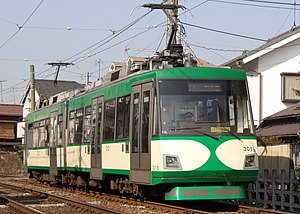Tōkyū Setagaya Line
| Tōkyū Setagaya Line | |||||||||||||||||||||||||||||||||||||||||||||||||||||||||||||||||||||
|---|---|---|---|---|---|---|---|---|---|---|---|---|---|---|---|---|---|---|---|---|---|---|---|---|---|---|---|---|---|---|---|---|---|---|---|---|---|---|---|---|---|---|---|---|---|---|---|---|---|---|---|---|---|---|---|---|---|---|---|---|---|---|---|---|---|---|---|---|---|
| Route length: | 5.0 km | ||||||||||||||||||||||||||||||||||||||||||||||||||||||||||||||||||||
| Gauge : | 1372 mm ( Scottish gauge ) | ||||||||||||||||||||||||||||||||||||||||||||||||||||||||||||||||||||
| Power system : | 600 V = | ||||||||||||||||||||||||||||||||||||||||||||||||||||||||||||||||||||
| Top speed: | 40 km / h | ||||||||||||||||||||||||||||||||||||||||||||||||||||||||||||||||||||
|
|||||||||||||||||||||||||||||||||||||||||||||||||||||||||||||||||||||
The Tōkyū Setagaya Line ( Japanese 東 急 世 田 谷 線 , Tōkyū Setagaya-sen ) is a tram line of the Tōkyō Kyūkō Dentetsu railway company in western Tokyo , which connects Sangen-Jaya with Shimo-Takaido over a length of 5 km . The line runs entirely in the Setagaya district , after which it was named.
As the only route on the Tōkyū, this route is legally classified as a tram , even if its character corresponds to that of a German light rail due to its continuous track structure. It is therefore one of the only surviving tram lines in Tokyo with the Toden Arakawa line . The route is completely double-tracked, apart from the terminals, where a single track with platforms on both sides is butt-turned.
Originally it was laid out in 1925 as a branch of the so-called Tamagawa Line (玉川 線), which from 1907 connected Shibuya Station with Tamagawa in the southwest. After re-gauging from 1067 mm to the still valid 1372 mm in 1920, two branches were also grown in the south, namely in 1924 to Kinuta (砧) and in 1927 to Mizonokuchi (溝 ノ 口). The extensions built at the same time in the north to Tengenji-bashi (天 現 寺 橋) and Naka-Meguro (中 目 黒) were taken over by the municipal transport office in 1948. The network was shut down in 1969 due to the construction of the underground, so that only the current route remained.
All stations have elevated platforms in a lateral position for boarding at the same level. The line is operated with two-part, light rail-like vehicles of the 300 series introduced in 1999. The fleet consists of ten railcars, all of which are painted in a different color.
Web links
- Official Japanese website. Retrieved November 3, 2016 (Japanese).



